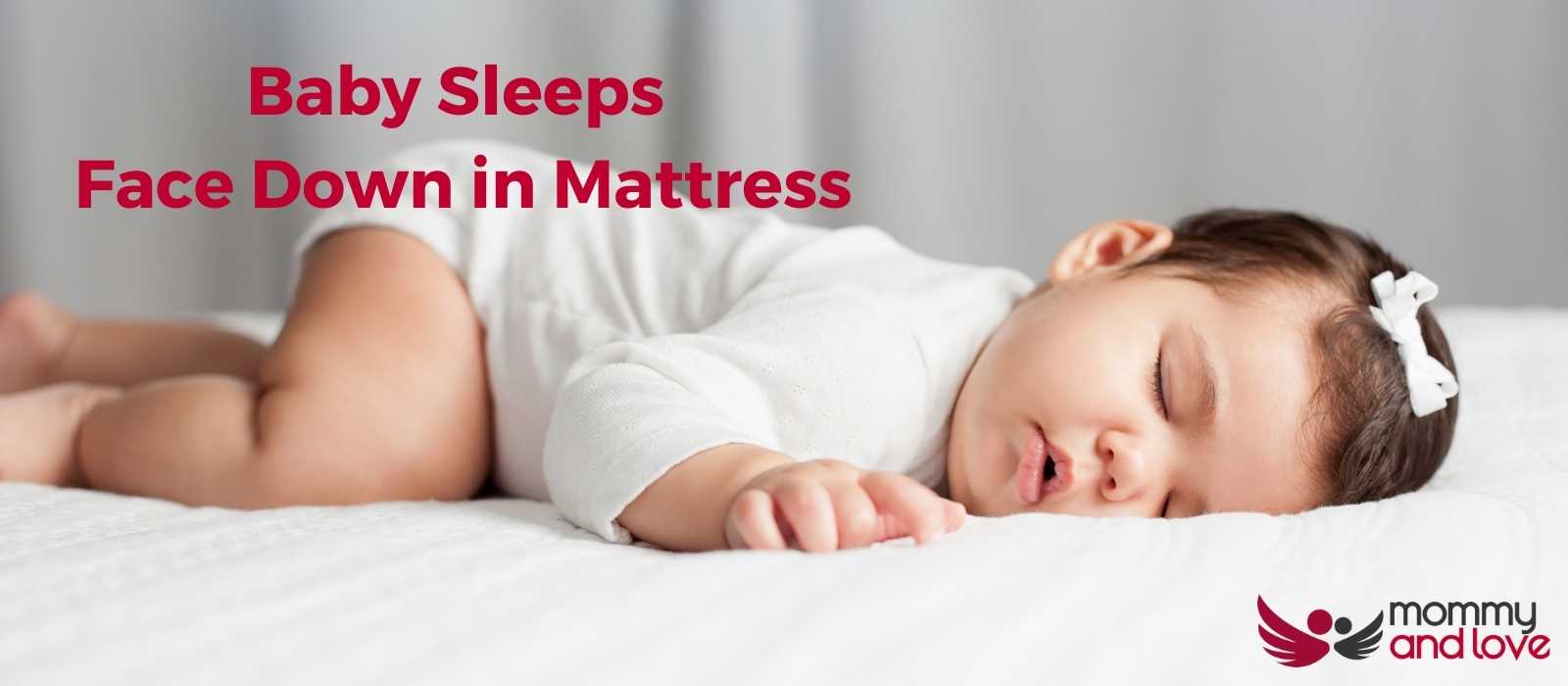It’s every parent’s worst nightmare: they wake up and found their baby sleeping face down on a mattress. Recently, there has been a lot of news about babies dying in this way, and many parents are wondering what they need to do to protect their babies
Parents should always place their baby on his or her back to sleep, in order to reduce the risk of Sudden Infant Death Syndrome.
Why Is It Bad for Babies Sleeping Face Down?
There are a few reasons and several factors to consider why sleeping face down or on the stomach is bad for babies.
- Increases the risk of SIDS. Babies who sleep face down are more likely to suffocate.
- Face-down sleeping can cause ear infections.
- When a baby sleeps face down, she is more likely to get flat heads.
- When babies sleep face down, they are more likely to drool and get their faces wet.
- Face-down sleeping can make it harder for babies to breathe. The intake of oxygen and release of carbon dioxide will be decreased.
- Even if babies learn how to lift their heads, sleeping face down is still not advisable.
Interestingly, a study done at the Saint Louis Children’s Hospital found out that children with experience sleeping on their stomachs had an easy time adjusting or rolling into different sleeping positions.
Safe Sleeping Habits for Babies to Avoid Sudden Infant Death Syndrome

If parents discover their baby sleeping face down or in a prone position, they shouldn’t worry. Many doctors and the back to sleep campaign by the National Institute of Health encourage parents and other caregivers to establish safe sleeping habits such as back sleeping for their babies from the very beginning to prevent them from breathing carbon dioxide.
By following some simple tips, you can help your little one sleep safely and soundly through the night.
Here are some tips for establishing a safe sleeping position and habits for your baby:
- The first few times babies sleep on their stomachs, put your baby to sleep on his or her back. This is the safest position for your baby to sleep in and will help reduce SIDS risks. Additionally, it prevents them from breathing their carbon dioxide and protect their head. It will also help them breathe easier.
- Use a firm mattress. A soft mattress can increase the risk of SIDS and sudden death, so it’s important to use a mattress that meets safety standards set forth by the Consumer Product Safety Commission.
- Make the new environment of your infant as safe as possible. Keep pillows, blankets, bumper pads, and stuffed animals out of the crib so that your babies can roll freely. These items can get on their head and be a suffocation hazard, especially for premature babies.
- Keep the crib clear of clutter. Any extra items such as stuffed toys in the crib can be a safety hazard to the head of inexperienced infants. This is also highly recommended for babies who are constantly rolling.
By following these simple tips, you can help ensure that your babies sleep soundly and safely in the back position through the night. Creating safe sleeping habits such as stomach sleeping for your baby is an important part of being a parent. By taking the time to establish these habits during the first few months of life, parents can help give your little one a lifetime of good sleep.
5 Tips to Make Baby Sleep on Their Backs
It’s important to keep your baby safe while they sleep, and one of the best ways to do that is to make sure they’re sleeping on their backs and not stomach sleeping. Here are five tips to help parents get their infants into back sleeping:
- Establish a bedtime routine: A bedtime routine will signal to your baby that it’s time to sleep. Try a simple routine of bathing, dressing for bed, and reading a short story together.
- Put your baby to her baby’s bed or crib drowsy but awake: This will help your baby learn to fall asleep on her own.
- Use a firm mattress: A firm mattress will provide the support your baby’s head and back need and will help prevent them from rolling over onto their stomach.
- Keep the room cool and comfortable: A cool, comfortable room will help your baby sleep and breathe better.
- Parents shouldn’t worry if their infants roll: If your baby rolls over during the night, don’t worry. Just make sure they’re still on their back when you check on them.
Following these tips will help you create a safe sleep environment for your baby and will help your babies learn to sleep on their backs for the entire first year of their life.
Why Does My Baby Bury His Face When Sleeping?

There are a few reasons why many babies may bury their faces when sleeping. One reason is that it helps them feel more secure.
When they’re swaddled tightly or have their head in a certain position, it can help them feel like they’re in a safe cocoon.
Another reason may be that your baby is trying to self-soothe. If they’re feeling overwhelmed or overstimulated, burying their face can help them calm down and drift off to sleep.
Lastly, it could be that your baby is simply comfortable sleeping with their face buried. Some healthy babies just prefer to sleep in this position and there’s no need to worry about it.
If you’re concerned about your baby’s face being burried, talk to your pediatrician. They can help you rule out any underlying medical conditions and offer guidance on how to keep your baby safe and comfortable.
Can a Baby Suffocate on a Mattress?

The short answer is yes. A baby can suffocate on a mattress if they are not properly supervised. Mattresses are made of soft materials that can block a baby’s airway and cause them to stop breathing.
If you are concerned about your baby suffocating on a mattress, there are some precautions you can take to help prevent this from happening.
Make sure to always put your baby to sleep on their back on a firm surface. This will help to prevent them from rolling onto their stomach and getting stuck.
You should also remove any pillows, blankets, or toys from the sleeping area so that your baby does not have anything around them that could block their airway. This is especially important for babies who can lift these objects and put it on their heads.
How Do I Stop My Baby From Putting His Face on the Mattress?
If your baby sleeps face down, there are a few things you can do.
First, try to prop your baby upon his or her side or stomach when they are awake and supervised.
Give them plenty of tummy time or stomach time to help strengthen their neck and back muscles.
Finally, make sure your baby has a mattress to sleep on or for tummy time. A soft mattress can increase the risk of flat head syndrome.
How Long Can a Baby Sleep Face Down?

The answer to this question depends on a few factors, including the age of the baby and the sleep environment.
In general, however, it is not recommended for babies to sleep face down for long periods of time.
The American Academy of Pediatrics recommends that babies under the age of 12 months old should not sleep face down for more than 15 minutes at a time. For babies over the age of 12 months, the AAP recommends that they should not sleep face down for more than 30 minutes at a time otherwise they will be inhaling exhaled carbon dioxide.
Of course, these are just guidelines. Parents should use their own judgment when it comes to their baby’s sleep habits. If you have any concerns about how your baby sleeps face down, always check with your child’s doctor.
Conclusion
So, is it safe for babies to sleep face down on the mattress? The answer, unfortunately, is no. Tummy sleeping increases the risk of sudden infant death syndrome (SIDS), and this position puts extra pressure on a baby’s fragile chest and lungs. It’s important to always place your child on their back when they sleep to reduce the risk of SIDS.




